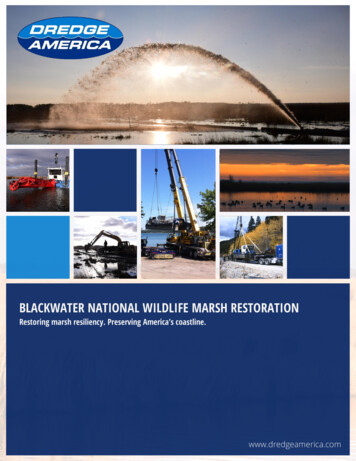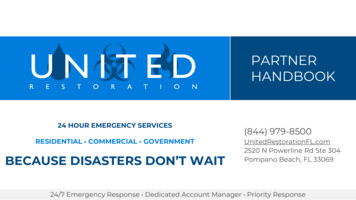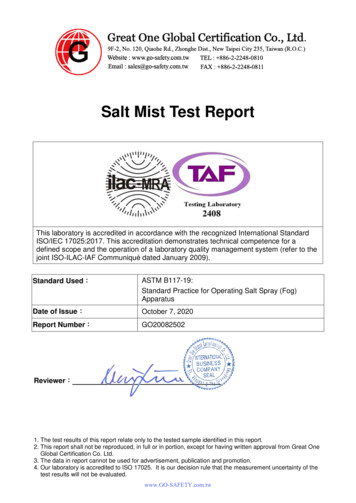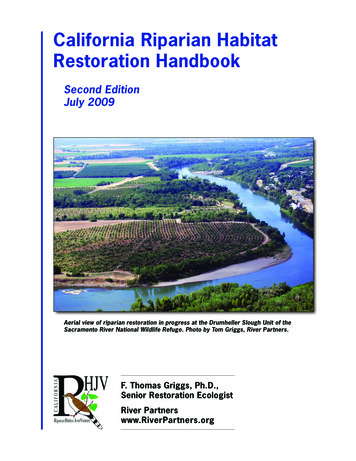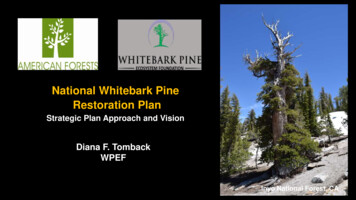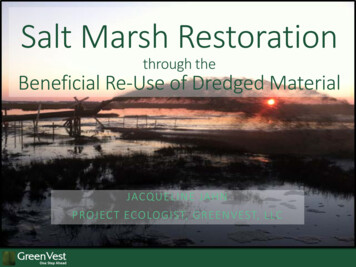
Transcription
Salt Marsh Restorationthrough theBeneficial Re-Use of Dredged MaterialJACQUELINE JAHNPROJECT ECOLOGIST, GREENVEST, LLC
Project Background Objective: Three trial projects to testthe marsh restoration throughbeneficial re-use concept Landowner: NJ Division of Fish &Wildlife Funding source: Hurricane SandyCoastal Resiliency grant (2-year) Project Team: The Nature ConservancyGreenVestPrinceton HydroThe Wetlands InstituteNJDEP and more.RECAP FROM WEBINAR 1
Project BackgroundOur Goals Trial the beneficial reuse of dredged material to restore salt marshesto prove the concept in NJ (can achieve ecological goals whileinflicting no harm) Collaborate with other resource agencies to best use limitedresourcesOur Objectives Implement multiple trial projects on multiple different sites Monitor projects to document success and challenges Disseminate lessons learned to facilitate future projects
Monitoring Elevation Depth and duration of flooding Vegetation Wildlife communities FishBirdsMacroinvertebratesBenthic infauna Sediments Wave energy & flooding modelling Adaptive Monitoring (post-con) Lessons learned and Cost analysis
Trial Projects Ring Island Thin Layer Placement Demonstration Project Aug – Sept 2014 Ring Island Shorebird Nesting Habitat Creation Aug – Sept 2014 Avalon Thin Layer Placement Demonstration Project – Phase 1 Dec 2014 – Jan 2015 Avalon Thin Layer Placement Demonstration Project – Phase 2 Nov 2015 – Feb 2016 Fortescue Marsh, Dune and Beach Restoration ongoing
Trial Projects Ring Island Thin Layer Placement Demo Project Aug – Sept 2014 Goal: Raise elevation of marsh toenhance plant communities by adding athin layer of dredged material 2 trial areas (1 acre total) 500-1,000 cy Spraying a sand/water slurry across thesalt marsh from edge Placement ranged from 0.5 – 9” Patchy recovery of plant communitiesare beginning to recover USACE & Barnegat Bay NJDEP & The Nature Conservancy
Trial Projects Ring Island Shorebird Nesting Habitat Creation Aug – Sept 2014 Goal: Elevate marsh above mean high tideto create shorebird nesting habitat byadding a thick layer of dredged sand 2 acre open sandy area 6,000 cy Pumping sand/water slurry, dewateringand grading The site has become a haven for coastalwildlife: American Oyster Catchers, Least Terns, andBlack-backed Gulls Horseshoe crabs and Terrapin turtles USACE & Barnegat Bay NJDEP, TNC & The Wetlands Institute
Trial Projects Avalon Thin Layer Placement Demonstration Project – Phase 1 Dec 2014 – Jan 2015 Goal: Fill unhealthy, expandingpools to restore/create contiguousmarsh plain and raise the elevationof the surrounding marsh 2 trial areas ( 5 ac total) 5,000 cy Spraying a sand/water slurry acrossthe salt marsh Limited containment Placement ranged from 0.5 – 18” USACE & Barnegat Bay NJDEP & The Nature Conservancy
Trial Projects Avalon Thin Layer Placement Demonstration Project – Phase 2 Nov 2015 – Feb 2016 Goal: Fill unhealthy, expanding pools tocreate contiguous marsh plain and raise theelevation of the surrounding marsh 5 placement areas ( 35 ac total) 45,000 cy Staging pipe in marsh and pumping asand/water slurry into pools Fully contained Placement ranged from 0.5 – 24” USACE & Barnegat Bay NJDEP, TNC, GreenVest & Princeton Hydro
AVALON PROJECT SITEThe problem: Expandingpool/degraded marsh complexesthreaten the integrity of the saltmarsh islandThe solution: Fill the pools tocreate contiguous marsh plain andraise the elevation of thesurrounding marsh
AVALON PROJECT SITEProject Implementation1. Sediment testing 60:20:20 SILT:clay:sand Dioxin/furans Bulking Channel Sediment: USACE &ERDC Marsh Sediment: NJDEP &Princeton Hydro
AVALON PROJECT SITE2. Project Design Target elevationsContainment needsConstruction constraintsGreenVest & PrincetonHydro
AVALON PROJECT SITEProject Implementation3. Containment Installation Semi-permeable coconut fiberlogs Small, shallow “confined disposalfacilities” GreenVest
AVALON PROJECT SITE4. Sediment placement Transport & dispersal45,000cy over 40 acresUSACE & Barnegat BayNJDFW & GreenVest
AVALON PROJECT SITE5. Planting Natural recruitment has already begun Planting will occur Spring 2017 GreenVestApril 25, 2016
So how did we get it done?
Agency Collaboration!o Early conversations between USACE – PhiladelphiaDistrict and NJ Division of Fish & Wildlife right afterHurricane Sandyo Interesto Feasibilityo Project siteso Fundingo Gathering a large multi-disciplinary project team andmaintaining regular communication
NJDEP’s perspective at the outset Willingness and impetus came from viewing these as PILOT projectsthat will be carefully monitored NJDFW gathered trusted partners and set regular communication NJDFW invited reps from other NJDEP departments early on, whowould participate in the project planning process
NJDEP’s Project TeamNJDEP - Division of Fish & WildlifeOffice of Sediment & Dredging TechnologyOffice of ScienceGREEN TRUST ALLIANCETHE NATURE CONSERVANCYMANAGEMENT OF PROJECT IMPLEMENTATIONMANAGEMENT OF PROJECT MONITORING GreenVest – project management,restoration design, constructionoversight and implementation,monitoring Princeton Hydro – engineering,construction oversight, monitoring Stockton University – monitoring,modelling Rutgers University – monitoring The Wetlands Institute – monitoring,education
Project Planning Process1.SITE ASSESSMENT 2.DEP attended site visitsStated that the marsh must be degraded and BU must be theappropriate solution“This is a restoration project not a disposal project.”CHANNEL SEDIMENT ASSESSMENT DEP performed independent assessmentContaminants: “like-on-like” policy; matching marsh areas and channelsegmentsTexture: some considerationBulking and consolidation: used to set max cy of dredged material
Project Planning Process3.RESTORATION PROJECT DESIGN DEP reviewed several draft plans and participated in all designdiscussionsRequired the use of bio-benchmarks to set target elevationsRequired containment measures to protect tidal creeks and efficientlyachieve target elevationsRequired detailed topographic survey to determine target volume ofdredged material and to determine containment needsTarget elevation was the only real success criteria but loose at thatbecause of uncertainties in bulking and consolidation
Project Planning Process4.PROJECT IMPLEMENTION PLANNING DEP attended all planning discussions and meetingsDEP attended pre-construction meetings with USACE and their dredgingcontractor, Barnegat Bat DredgingRequired containment to be biodegradableRequired a DEP representative out on the marsh during constructionRequired weekly communication on constructionSet timing restrictions for sensitive wildlifeSet guidelines on working during specific tidal conditions and night timeRequired grade stakes as a visual guide on when to stop pumping, but nofixed requirement to revisit an area to meet gradeSet max. volume per marsh area, but allowed for easy permit modificationdue to uncertainties in bulking and consolidationSet guidelines on how to adaptively manage construction, especially anybreaches in containment
Finally Permits! Permits required: Project-specific conditions: Coastal General Permit #24 for Habitat creation, restoration, enhancement Clean Water Act Section 401 Water Quality Certificate Coastal Zone Management Program Consistency Determination No dredging between April 1 and Aug 31Max volume of dredged materialPermitted target elevations and volumes per areaSediments w elevated levels of dioxins could only be placed withindesignated areas on the marsh (like-on-like)Minimize/document dispersal of sediments beyond area boundariesMinimize impact to marsh by equipmentPlantMonitorThe key to permitting this project was intense participation by DEPthroughout
DEP during constructionWeekly communication and troubleshooting!Allowances made for certain circumstances.
DEP after constructionWeekly communications on monitoring andadaptive management Interpreting results of monitoring Tracking unexpected results Containment management Vegetation die-off areas
NJDEP’s thoughts going forwardo A bit cautious to move forward until these pilot projects are completeand lessons are derived.o Bulking and consolidation for better planningo Reaction of marsh to the dredged material (chemical and physical)to establish thresholds (marsh compaction, smothering depth)o Issues with containmento Success or failure of original, recruited and planted material atvarious depths (recovery trajectories)o Costso Working on developing a permit application checklisto Working on site assessment policies and how to ID if a marsh is acandidate (established the Coastal Ecological Projects Committee
Looking forward Spring 2017 planting Continued monitoring within grant Acquiring funding to monitor long-term Publication of a team-authored white paper Distilling lessons learned for future projects
Thank you.
Apr 11, 2017 · Spring 2017 planting Continued monitoring within grant Acquiring funding to monitor long -term Publication of a team-authored white paper Distilling lessons learned for future pro


